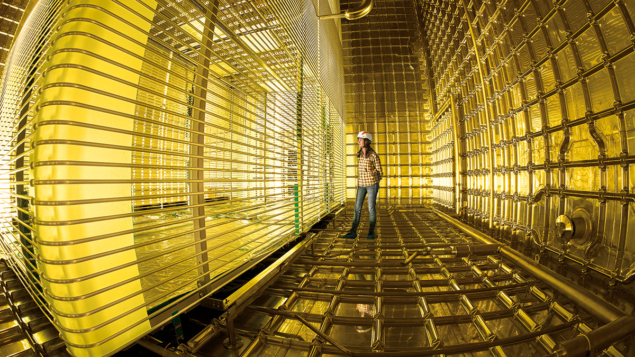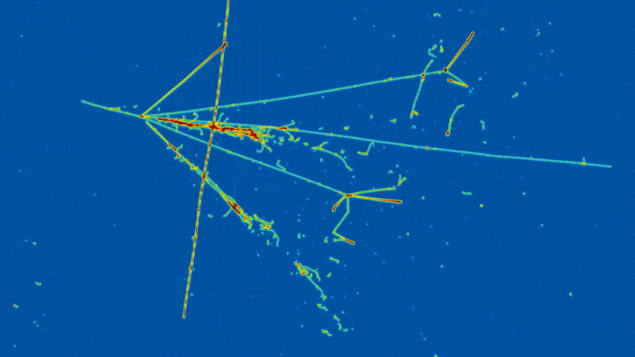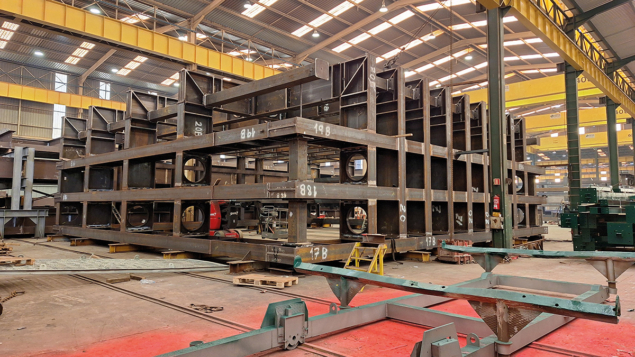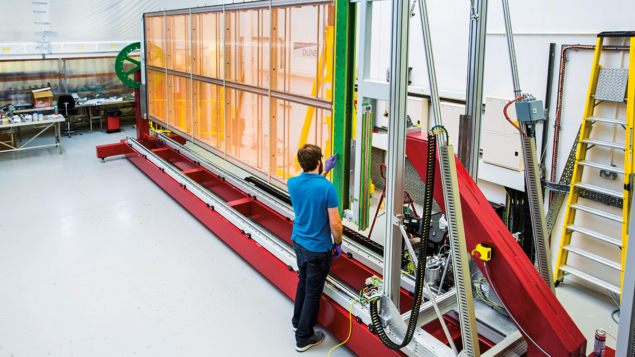In 1968, deep underground in the
Homestake gold mine in South Dakota, Ray Davis Jr. observed too few
electron neutrinos emerging from the Sun. The reason, we now know, is
that many had changed flavour in flight, thanks to tiny unforeseen
masses.
At the same time, Steven Weinberg and Abdus Salam were
carrying out major construction work on what would become the Standard
Model of particle physics, building the Higgs mechanism into Sheldon
Glashow’s unification of the electromagnetic and weak interactions. The
Standard Model is still bulletproof today, with one proven exception:
the nonzero neutrino masses for which Davis’s observations were in
hindsight the first experimental evidence.
Today, neutrinos are
still one of the most promising windows into physics beyond the Standard
Model, with the potential to impact many open questions in fundamental
science (CERN Courier May/June 2024 p29).
One of the most ambitious experiments to study them is currently taking
shape in the same gold mine as Davis’s experiment more than half a
century before.
Deep underground
In
February this year, the international Deep Underground Neutrino
Experiment (DUNE) completed the excavation of three enormous caverns
1.5 kilometres below the surface at the new Sanford Underground Research
Facility (SURF) in the Homestake mine. 800,000 tonnes of rock have been
excavated over two years to reveal an underground campus the size of
eight soccer fields, ready to house four 17,500 tonne liquid–argon
time-projection chambers (LArTPCs). As part of a diverse scientific
programme, the new experiment will tightly constrain the working model
of three massive neutrinos, and possibly even disprove it.
DUNE
will measure the disappearance of muon neutrinos and the appearance of
electron neutrinos over 1300 km and a broad spectrum of energies. Given
the long journey of its accelerator-produced neutrinos from the Long
Baseline Neutrino Facility (LBNF) at Fermilab in Illinois to SURF in
South Dakota, DUNE will be uniquely sensitive to asymmetries between the
appearance of electron neutrinos and antineutrinos. One predicted
asymmetry will be caused by the presence of electrons and the absence of
positrons in the Earth’s crust. This asymmetry will probe neutrino mass
ordering – the still unknown ordering of narrow and broad mass
splittings between the three tiny neutrino masses. In its first phase of
operation, DUNE will definitively establish the neutrino mass ordering
regardless of other parameters.

Vertical drift A physicist studies the field cage of a prototype liquid–argon time-projection chamber at CERN.
Credit: M Cavazza/CERN-PHOTO-202308-195-28
If
CP symmetry is violated, DUNE will then observe a second asymmetry
between electron neutrinos and antineutrinos, which by experimental
design is not degenerate with the first asymmetry. Potentially the first
evidence for CP violation by leptons, this measurement will be an
important experimental input to the fundamental question of how a
matter–antimatter asymmetry developed in the early universe.
If CP violation is near maximal, DUNE will observe it at 3σ (99.7%
confidence) in its first phase. In DUNE and LBNF’s recently
reconceptualised second phase, which was strongly endorsed by the US
Department of Energy’s Particle Physics Project Prioritization Panel
(P5) in December (CERN Courier January/February 2024 p7), 3 σ sensitivity to CP violation will be extended to more than 75% of possible values of δCP, the complex phase that parameterises this effect in the three-massive-neutrino paradigm.
Combining
DUNE’s measurements with those by fellow next-generation experiments
JUNO and Hyper-Kamiokande will test the three-flavour paradigm itself.
This paradigm rotates three massive neutrinos into the mixtures that
interact with charged leptons via the Pontecorvo–Maki–Nakagawa–Sakata
(PMNS) matrix, which features three angles in addition to δCP.
As well as promising world-leading resolution on the PMNS angle θ23, DUNE’s measurements of θ13 and the Δm232
mass splitting will be different and complementary to those of JUNO in
ways that could be sensitive to new physics. JUNO, which is currently
under construction in China, will operate in the vicinity of a flux of
lower-energy electron antineutrinos from nuclear reactors. DUNE and
Hyper-Kamiokande, which is currently under construction in Japan, will
both study accelerator-produced sources of muon neutrinos and
antineutrinos, though using radically different baselines, energy
spectra and detector designs.
Innovative and impressive
DUNE’s
detector technology is innovative and impressive, promising
millimetre-scale precision in imaging the interactions of neutrinos from
accelerator and astrophysical sources (see “Millimetre precision”
image). The argon target provides unique sensitivity to low-energy
electron neutrinos from supernova bursts, while the detectors’ imaging
capabilities will be pivotal when searching for
beyond-the-Standard-Model physics such as dark matter, sterile-neutrino
mixing and non-standard neutrino interactions.
First proposed by
Nobel laureate Carlo Rubbia in 1977, LArTPC technology demonstrated its
effectiveness as a neutrino detector at Gran Sasso’s ICARUS T600
detector more than a decade ago, and also more recently in the
MicroBooNE experiment at Fermilab. Fermilab’s short-baseline neutrino
programme now includes ICARUS and the new Short Baseline Neutrino
Detector, which is due to begin taking neutrino data this year.
 Millimetre precision A 6 GeV charged pion (left) ejects a proton (top) from an argon nucleus in the single-phase ProtoDUNE detector at CERN.
Millimetre precision A 6 GeV charged pion (left) ejects a proton (top) from an argon nucleus in the single-phase ProtoDUNE detector at CERN.
Three
charged pions and two photons also emerge from the vertex, and a
stopping cosmic-ray muon is seen crossing the event. Credit: NP04
Collaboration
The first phase of DUNE will construct one
LArTPC in each of the two detector caverns, with the second phase adding
an additional detector in each. A central utility cavern between the
north and south caverns will house infrastructure to support the
operation of the detectors.
Following excavation by Thyssen
Mining, final concrete work was completed in all the underground caverns
and drifts, and the installation of power, lighting, plumbing, heating,
ventilation and air conditioning is underway. 90% of the subcontracts
for the installation of the civil infrastructure have already been
awarded, with LBNF and DUNE’s economic impact in Illinois and South
Dakota estimated to be $4.3 billion through fiscal years 2022 to 2030.
Once
the caverns are prepared, two large membrane cryostats will be
installed to house the detectors and their liquid argon. Shipment of
material for the first of the two cryostats being provided by CERN is
underway, with the first of approximately 2000 components having arrived
at SURF in January; the remainder of the steel for the first cryostat
was due to have been shipped from its port in Spain by the end of May.
The manufacture of the second cryostat by Horta Coslada is ongoing (see
“Cryostat creation” image).
Procedures for lifting and
manipulating the components will be tested in South Dakota in spring
2025, allowing the collaboration to ensure that it can safely and
efficiently handle bulky components with challenging weight
distributions in an environment where clearances can reach as little as
3 inches on either side. Lowering detector components down the Homestake
mine’s Ross shaft will take four months.
Two configurations
The
two far-detector modules needed for phase one of the DUNE experiment
will use the same LArTPC technology, though with different anode and
high-voltage configurations. A “horizontal-drift” far detector will use
150 6 m-by-2.3 m anode plane assemblies (APAs). Each will be wound with
4000 150 μm diameter copper-beryllium wires to collect ionisation
signals from neutrino interactions with the argon.
 Cryostat creation The pre-assembly of a section of the second cryostat for DUNE at the factory in Arteixo, Spain.
Cryostat creation The pre-assembly of a section of the second cryostat for DUNE at the factory in Arteixo, Spain.
Credit: CERN
A
second “vertical-drift” far detector will instead use charge readout
planes (CRPs) – printed circuit boards perforated with an array of holes
to capture the ionisation signals. Here, a horizontal cathode plane
will divide the detector into two vertically stacked volumes. This
design yields a slightly larger instrumented volume, which is highly
modular in design, and simpler and more cost-effective to construct and
install. A small amount of xenon doping will significantly enhance photo
detection, allowing more light to be collected beyond a drift length of
4 m.
The construction of the horizontal-drift APAs is well
underway at STFC Daresbury Laboratory in the UK and at the University
of Chicago in the US. Each APA takes several weeks to produce,
motivating the parallelisation of production across five machines in
Daresbury and one in Chicago. Each machine automates the winding of
24 km of wire onto each APA (see “Wind it up” image). Technicians then
solder thousands of joints and use a laser system to ensure the wires
are all wound to the required tension.
Two large ProtoDUNE
detectors at CERN are an essential part of developing and validating
DUNE’s detector design. Four APAs are currently installed in a
horizontal-drift prototype that will take data this summer as a final
validation of the design of the full detector. A vertical-drift
prototype (see “Vertical drift” image) will then validate the production
of CRP anodes and optimise their electronics. A full-scale test of
vertical-drift-detector installation will take place at CERN later this
year.
Phase transition
Alongside
the deployment of two additional far-detector modules, phase two of the
DUNE experiment will include an increase in beam power beyond 2 MW and
the deployment of a more capable near detector (MCND) featuring a
magnetised high-pressure gaseous-argon TPC. These enhancements pursue
increased statistics, lower energy thresholds, better energy resolution
and lower intrinsic backgrounds. They are key to DUNE’s measurement of
the parameters governing long-baseline neutrino oscillations, and will
expand the experiment’s physics scope, including searches for anomalous
tau-neutrino appearance, long-lived particles, low-mass dark matter and
solar neutrinos.

Wind it up A winding machine producing a ProtoDUNE anode plane assembly at Daresbury Laboratory in the UK.
Credit: Daresbury Laboratory
Phase-one
vertical-drift technology is the starting point for phase-two
far-detector R&D – a global programme under ECFA in Europe and CPAD
in the US that seeks to reduce costs and improve performance.
Charge-readout R&D includes improving charge-readout strips, 3D
pixel readout and 3D readout using high-performance fast cameras.
Light-readout R&D seeks to maximise light coverage by integrating
bare silicon photomultipliers and photoconductors into the detector’s
field-cage structure.
A water-based liquid scintillator module
capable of separately measuring scintillation and Cherenkov light is
currently being explored as a possible alternative technology for the
fourth “module of opportunity”. This would require modifications to the
near detector to include corresponding non-argon targets.
Intense work
At
Fermilab, site preparation work is already underway for LBNF, and
construction will begin in 2025. The project will produce the world’s
most intense beam of neutrinos. Its wide-band beam will cover more than
one oscillation period, allowing unique access to the shape of the
oscillation pattern in a long-baseline accelerator-neutrino experiment.
LBNF
will need modest upgrades to the beamline to handle the 2 MW beam power
from the upgrade to the Fermilab accelerator complex, which was
recently endorsed by P5. The bigger challenge to the facility will be
the proton-target upgrades needed for operation at this beam power.
R&D is now taking place at Fermilab and at the Rutherford Appleton
Laboratory in the UK, where DUNE’s phase-one 1.2 MW target is being
designed and built.
"The next generation of big neutrino experiments promises to bring new insights into the nature of our universe"
DUNE
highlights the international and collaborative nature of modern
particle physics, with the collaboration boasting more than 1400
scientists and engineers from 209 institutions in 37 countries. A
milestone was achieved late last year when the international community
came together to sign the first major multi-institutional memorandum of
understanding with the US Department of Energy, affirming commitments to
the construction of detector components for DUNE and pushing the
project to its next stage. US contributions are expected to cover
roughly half of what is needed for the far detectors and the MCND, with
the international community contributing the other half, including the
cryostat for the third far detector.
DUNE is now accelerating into
its construction phase. Data taking is due to start towards the end of
this decade, with the goal of having the first far-detector module
operational before the end of 2028.
The next generation of big
neutrino experiments promises to bring new insights into the nature of
our universe – whether it is another step towards understanding the
preponderance of matter, the nature of the supernovae explosions that
produced the stardust of which we are all made, or even possible
signatures of dark matter… or something wholly unexpected!
Further reading
DUNE Collab. 2022 JINST 17 P01005.